A Patent Pending Pinfire Clock Gun Bird Scarer


We talked before about John Hall and his patented automatic clock gun (linked below.) This article will explore another gun that draws heavily on the concept and design, likely because it was probably also made by John Hall. Make sure to watch the video of it in action at the very bottom!
The last article stopped around 1902, when John Hall patented his automatic clock gun and received reviews and media attention for it. However, John Hall did not stop making automatic clock-gun bird scarers then. John Hall & Son made them for at least another 50 years! In 1951 they were still listed under the Bird Scarers category in the Commercial Growers’ Directory & Buyer’s Guide.
In the 1902 patent, Hall mentions that “It will be evident that some of the details of construction can be modified without departing from the scope of the invention; for instance the threads may be secured in the path of the knife by means of spring clips in place of the notches; the pegs may also be replaced by any other suitable tightening devices.” He also mentions that “it must be understood that the apparatus may be made of any size and with any required number of barrels and firing devices.”
The example in this article follows some of this advice. It holds 18 pinfire cartridges and has the spring-clip based attachment to the clock instead of the threads that get cut with a knife clock hand as shown on the other example.

Rather than having the weights rest on the threads as in the other example, this model has thicker ropes that are permanently attached to the end of the weights and hang from the tension of the spring clip hooked into the clock. There is a safely mechanism of a long bar that runs through the barrels that the weights can rest on without having to have the clips set or worrying about it going off before everything is set and ready.

This bar will be pulled all the way out when the bird scarer is ready to be used, letting the weights hang inside the barrel ready to let gravity allow them to become a hammer that fires a pinfire cartridge.
This model is marked as “patent applied for” with a patent application number of 15,175 from May 22, 1934. There does not seem to be a corresponding issued patent so this application must have been withdrawn or denied. It is possible someone else tried to patent this 30 years after the other model was made and it was denied, but they really are so similar that it is likely John Hall & Son planned on getting more patent protection on this variation they were selling at the time.

And here is a video of it in action!





 Hello, my name is Aaron Newcomer. I am a collector and researcher of early 19th century breech-loading firearms systems, with a particular focus on the work of Jean Samuel Pauly and Casimir Lefaucheux. I collect cartridges and documents related to these types of firearms and conduct research on these topics, furthering my understanding and knowledge of these historical firearms and their place in the evolution of firearms technology. My collection and research reflect my dedication to preserving and understanding the history and technical innovations of these early firearms systems.
Hello, my name is Aaron Newcomer. I am a collector and researcher of early 19th century breech-loading firearms systems, with a particular focus on the work of Jean Samuel Pauly and Casimir Lefaucheux. I collect cartridges and documents related to these types of firearms and conduct research on these topics, furthering my understanding and knowledge of these historical firearms and their place in the evolution of firearms technology. My collection and research reflect my dedication to preserving and understanding the history and technical innovations of these early firearms systems.




